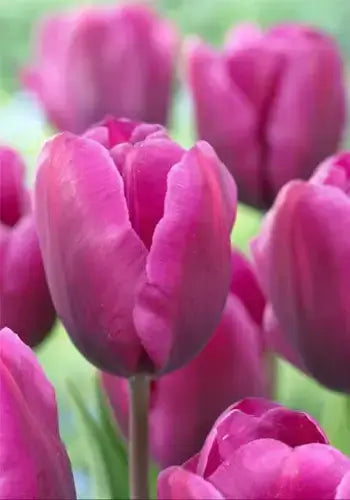Perennials 101
Most gardeners have experienced this: you see a gorgeous color photo of a perennial in a catalog, you order one, it arrives, you plant it, and then, after you think you've done everything right, it just…doesn't look right. Where are all those colorful blooms and vigorous growth?
There are a few things to keep in mind. First, catalog photos will often be of mature plants taken on a sunny day. Also, the plants may have been fed extra fertilizer to encourage more giant flowers and faster growth. Finally, catalog photos are sometimes retouched to look brighter and more vivid than the original image.
Perennial Planting
Proper Planting Zone: Know your USDA Zone! And check the zone of the perennial you want to plant. Some varieties of perennials have different hardiness zones. For example, some macrophylla hydrangeas won't form buds below Zone 5 and might need winter protection to protect them from exposure to cold. 'Nikko Blue' is a relatively cold-hardy blue-flowering hydrangea. You can also try a variety suited to your zone: a 'Mini Mauvette' hydrangea is cold hardy to Zone 3. Other plants you should double check for proper zone: coreopsis, snapdragons, gladiolus, and dahlias. You may have to grow some plants as annuals if they're not cold-hardy in your area. Likewise, some perennials need a long cold period to form buds, like hyacinths and peonies.
Soil Texture: All gardens begin with good soil. This means soil that holds moisture yet has good drainage that is rich with organic matter. If you have thick clay soil, drainage is poor, and nutrients cannot permeate through the roots of plants. Adding compost, composted manure, and humus-rich soil is the best way to get a good base for growing perennials. If your soil is sandy and loamy, you can also enrich it with compost. Used coffee grounds and wood ash from an outdoor fire (no
treated wood, please) can also be added to your soil. Coffee grounds add a slightly more acidic element, suitable for shade plants, while wood ash is more alkaline. These terms, acid and alkaline, refer to soil pH, our next topic.
Soil pH: The pH of your soil refers to acidity and alkalinity. A numerical system for soil testing measures the pH, and you can adjust it accordingly. If you have pine trees or other evergreens that drop needles on your garden, your soil is likely to be acidic, affecting how perennials grow. Adding some compost, lime (a powdered soil amendment made from limestone), or wood ash will help balance your soil's acidity. If you have the opposite problem, too much alkalinity (common if your garden is on land with limestone deposits), adding some composted manure, used coffee grounds, or peat moss will help balance the soil.
Sunlight: Most flowering perennials need at least some sun to bloom. Some won't bloom without sufficient sunlight: for example, echinacea needs at least five hours of direct sunlight to form big blooms. Sedums won't flower in full shade. Look at the perennial's sunlight requirements and make sure you plant them in an appropriate spot. Remember that afternoon sunlight is generally brighter than morning sunlight, which helps you plan strategically if you have limited hours of sun. Golden Rod looks amazing in landscapes, and they love sunshine.
Crowding: Your perennials may be growing too close together. You planted them a few inches apart, but they got bigger. This can happen before you know it! Many gardeners like that complete look, so they often divide perennials between making space when things get too cozy. Some perennials will get mildewy if they're too close to other plants, like phlox or bee balm. Some plants need frequent dividing to stay neat looking (like 'Silver Mound' artemisia, which needs to be split every year). Some do fine if divided every 3-4 years, like daylilies, sedums, astilbes, or German irises.
Proper Planting: Some plants are fussy about their planting conditions. Planting them too shallowly or too deeply can affect blooming. Peonies are a good example: they should be planted at a depth no more than two inches above the crown of the buds. Once they're happily situated, they'll live for fifty years. Perennial bulbs like daffodils and hyacinths also benefit from being planted at the proper depth. Make sure rootbound perennials are gently prepared. You can use a gardening knife or other hand tools to loosen the roots and cut some space into them. If the roots are dehydrated, moistening them with water can make loosening them a bit easier. Large perennials should be watered well before filling the planting hole with soil. Adding some soil amendments to the planting is also suitable for giving your plants a good start. Water them well, and water them once a day for about a week until they're established. Goats Beard Plant makes a great border plant!
Pests: Humans love flowers, and so do animals. Deer love to nibble on Hostas and are known to gobble rosebuds and sedum flowers. Some pesky squirrels will dig up fall-planted bulbs. Then there are insect pests: lily beetles, Japanese, caterpillars, etc. There are non-toxic sprays to keep deer away and bulb netting to deter squirrels. Natural methods abound for insect pests, too, like putting milky spores around the bases of your roses to deter Japanese beetles. Lily beetles hate garlic, and you can put garlic powder, vegetable oil, and a bit of dish soap in some water and spray on your Asiatic lilies to keep these destructive pests away. Gardeners are often clever in finding creative, non-toxic solutions for pests, so research natural pest control methods.



